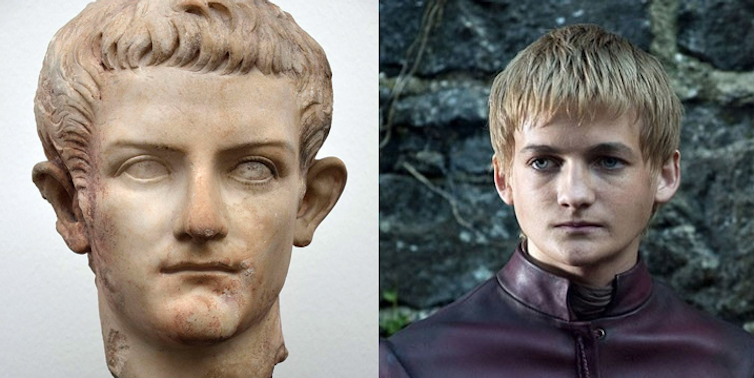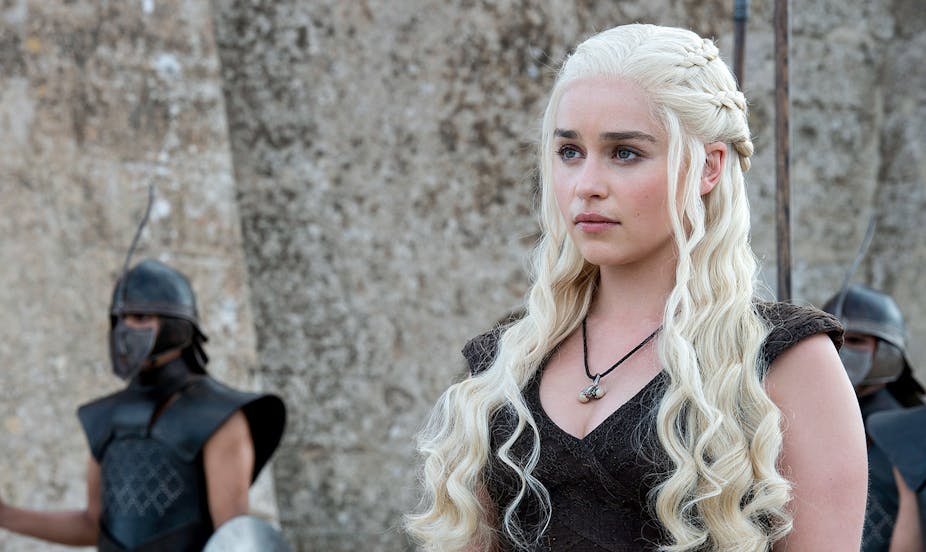Although the universe of Game of Thrones is steeped in a medieval atmosphere, several of the central in the series – Daenerys Targaryen, Joffrey Baratheon and Jon Snow – seem directly inspired by characters from Roman antiquity.
George R.R. Martin, author of the novels behind the hit HBO series, has affirmed that the history of the Roman Empire was one of his sources of inspiration. Indeed, it was the 117km wall that the Emperor Hadrian had built in the north of England in the years 120 AD that gave him the idea of the Wall.
Martin tells of visiting the site one autumn evening: the sun was setting and it was getting cold. After the departure of the last tourists, the novelist said he felt the loneliness and homesickness of the Roman legionaries posted there 2,000 years ago.
Of course, the author’s imagination has transformed Hadrian’s Wall into an immense barrier of ice in the Game of Thrones saga. At 200 meters high, Martin’s Wall is worlds away on Hadrian’s fortification, but its function remains the same as that in Antiquity: to preserve the “civilized” world from a formidable external threat.
To breathe life into his fictional characters, Martin was able to exploit and adapt elements found in the work of ancient historians, including Suetonius, Tacitus and Dio Cassius. He also drew inspiration from the landmark television series I, Claudius (BBC, 1976), and Rome (2005-2007).
Like Game of Thrones, the HBO series Rome featured abundant violence and cruelty that was intimately linked to the political sphere, the ambitions of its leaders and their thirst for domination.
Three atrocious deaths
In 60 BC, three powerful men concluded a secret alliance to jointly control the Roman Empire: the military leader Pompey the Great, the rich Crassus, and the ambitious Julius Caesar, who dreamed of turning the Republic into a monarchy. The members of this triumvirate will each experience a violent and atrocious death.
Crassus, who thought he could defeat with the Parthians, enemies to the east of Rome, was defeated at the Battle of Carrhae in 53 BC. According to a tradition reported by Dio Cassius (Roman History 40.27), after Crassus’ death, the victors pour molten gold into his mouth as a symbolic punishment for his inexhaustible greed. Viserys Targaryen will suffer a similar punishment.
After being defeated at the Battle of Pharsalus in 48 BC, Pompey fled to Egypt, where he was decapitated – like Eddard Stark](https://time.com/5203015/sean-bean-ned-stark-beheading-praying/). Four years later, Julius Caesar is stabbed to death by a group of traitors, including his adopted son Brutus. “You too, my son,” would be Caesar’s last words. In the same way, Jon Snow will be the victim of a conspiracy hatched by his entourage. The young Olly, playing the role of Brutus, carries out the coup de grace.
Jon Snow: Jesus meets Caesar

After his death, Julius Caesar, the idol of the lower classes, is deified and a temple is dedicated to him on the Roman Forum. Jon Snow follows the model of Jesus, another historical figure of the Roman era. By his physical appearance alone, Snow is clearly in the tradition of Christian iconography. His politico-military aspect is modeled on Caesar, however: Snow possesses the charisma and virtues of the ideal leader who puts himself at the head and in the service of his people.
Game of Thrones also contains several adaptations of political characters from imperial Rome. In contrast to Julius Caesar, a positive figure, Caligula, the third Roman emperor, represents the delusional Caesar. Suetonius, author of the Life of the Twelve Caesars, portrays a tyrant as violent as it is unpredictable. Caligula has three major characteristics: he is young, cruel and crazy.
The resemblance of Caligula to Joffrey Baratheon is striking, both in terms of his character and physical appearance. Even the hair of actor Jack Gleeson is styled in the same way as the emperor on his official portraits.

Caligula had previously been portrayed on screen in 1979 by Malcolm McDowell in Tinto Brass’s Caligula. The notorious film added an erotic and cruel aspect to the classic Roman sword-and-sandal epic, prefiguring Rome and Game of Thrones.
The historian Suetonius stated that Caligula had incestuous relations with his sister Drusilla. In Game of Thrones, a forbidden love links Cersei to her brother Jaime. Cersei also resembles the empress Agrippina, a cunning and unscrupulous figure who wanted to reign through her son Nero. He became emperor at the age of just 17, a young man like Tommen.
Claudius, the uncle of Caligula, was scorned in his youth because of physical disabilities and was dismissed as an idiot. His own mother called him a man “unfinished by nature”, yet he revealed a great political finesse, as does Tyrion Lannister in Game of Thrones. Caligula-Joffrey and Claudius-Tyrion, the nephew and the uncle, form a contradictory pair: on one side the cruel young sovereign, on the other, the intelligent man unjustly denigrated because of his physical appearance. Do not be fooled by appearances.
From Boudica to Daenerys

Boudica or Boadicea (circa 30-61 AD) was a queen of the Icenians, Celtic people of ancient England, near present-day Norfolk. Since the Roman conquest and the transformation of the south of the island into the province of the Empire, the local people, dominated, were treated as slaves by the Roman occupiers. Boudica herself had been beaten and her two daughters raped by legionaries. In 61 AD, she managed to gather a powerful army and led an uprising of the humiliated populations against their foreign masters.
The historian Dio Cassius evokes the queen in his Roman history (62.2), emphasizing her feminine power: “She let down her thick, blond hair, down to her lower back”. A warrior, she was armed with a spear and spoke to her troops to exalt them in battle.
Boudica figurines became popular in England from the 19th century, and a statue representing her in a chariot was erected in London near Westminster Bridge. She is the heroine of novels and films, including Legions: The Warriors of Rome (2003). Naturally, any resemblance to Daenerys in Game of Thrones is strictly coincidental.


